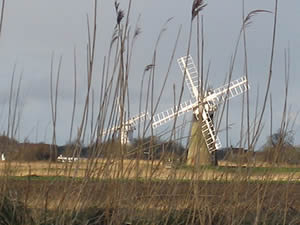Norfolk Broads facts for kids
The Broads are a special network of rivers and lakes in the east of England. You can find them mostly in the county of Norfolk, with some parts in Suffolk. This amazing watery landscape is a bit like a national park. It was made a protected area by a law called The Norfolk and Suffolk Broads Act in 1988. Since 1989, a group called the Broads Authority has looked after this beautiful place.
The Broads cover a total area of about 303 square kilometres (117 sq mi) (that's about 117 square miles!). Most of this area is in Norfolk. There are over 200 kilometres (120 mi) (about 124 miles) of waterways where boats can travel. You'll find seven main rivers and 63 lakes, which are called "broads." Most of these broads are not very deep, usually less than 4 metres (13 ft) (about 13 feet).
Out of the 63 broads, 13 are usually open for boats to explore. Another three have special channels that boats can use. Even though some parts are called "Norfolk Broads" and others "Suffolk Broads," people often just call the whole area "the Norfolk Broads."
Contents
What Are The Broads?
The Broads are not natural lakes! They were actually dug out by people a long, long time ago. In the Middle Ages, people needed peat for fuel. Peat is like a type of soil made from old, decayed plants. They dug up huge amounts of peat, creating big holes in the ground.
Over time, these holes filled with water as the sea level rose. This created the lakes and rivers we see today. So, The Broads are a unique example of how human activity can shape the landscape in unexpected ways.
Exploring The Broads
The Broads are a very popular place for holidays and outdoor activities. Many people come here to enjoy boating, fishing, and birdwatching.
Boating and Waterways
With over 200 kilometres (120 mi) of waterways, The Broads are perfect for boating. You can hire different types of boats, from small electric boats to larger yachts. It's a great way to explore the quiet rivers and broads. Many people enjoy sailing here because the waters are often calm.
Wildlife and Nature
The Broads are home to a wide variety of plants and animals. It's a very important place for wildlife. You might spot rare birds, like the bittern or the marsh harrier. Many different types of fish live in the rivers and lakes. The area also has special plants that grow in the wetlands.
Historic Windmills
As you travel through The Broads, you'll see many old windmills. These windmills were not used to grind corn like some others. Instead, they were used to pump water away from the land. This helped to keep the surrounding fields dry for farming. Many of these historic mills are still standing, and some have been restored.
Protecting The Broads
The Broads are a very special place, so it's important to protect them. The Broads Authority works hard to keep the area healthy and beautiful. They manage the waterways, look after the wildlife, and help visitors enjoy the area responsibly. This includes protecting rare species and making sure boats don't cause too much damage to the riverbanks.
Images for kids
-
The point at which the River Yare and the River Waveney merge into Breydon Water
-
Yachts on the Norfolk Broads
-
The derelict Brograve Mill, on the Waxham New Cut near Horsey
See also
 In Spanish: Parque nacional The Broads para niños
In Spanish: Parque nacional The Broads para niños













